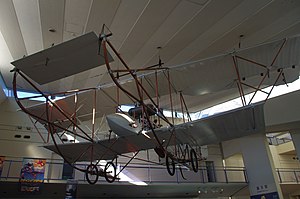Kaishiki No.1
You can help expand this article with text translated from the corresponding article in Japanese. (February 2016) Click [show] for important translation instructions.
|
| Kaishiki No.1 | |
|---|---|

| |
| Replica at Tokorozawa Aviation Museum | |
| Role | First military airplane designed and flown in Japan |
| National origin | Japan |
| Designer | Yoshitoshi Tokugawa |
| Number built | 1 |
| Developed from | Farman III |
| Developed into | Kaishiki No.2-6 |
| Other name(s) | Kaishiki 1, Kaishiki Biplane 1 |
| Type | Experimental biplane |
| First flight | October 13, 1911 |
The 会式一号機 (Kaishiki No.1, kaishikiichigouki) was the first successful[a] Japanese-designed and constructed airplane. It was designed by Captain Yoshitoshi Tokugawa and was first flown by him on October 13, 1911, at Tokorozawa in Saitama Prefecture.[2]
There is a replica displayed in the Tokorozawa Aviation Museum, located near the place where the aircraft's first flight took place.[3]
Specifications[edit]
Data from Japanese Aircraft 1910–1941[1]
General characteristics
- Crew: 2
- Length: 11.50 m (37 ft 9 in)
- Upper wingspan: 10.50 m (34 ft 5 in)
- Lower wingspan: 8.0 m (26 ft 3 in)
- Height: 3.90 m (12 ft 10 in)
- Wing area: 41.0 m2 (441 sq ft)
- Empty weight: 450 kg (992 lb)
- Gross weight: 550 kg (1,213 lb)
- Powerplant: 1 × Gnome Omega 7-cylinder rotary engine, 37 kW (50 hp)
- Propellers: 2-bladed Chauvière
Performance
- Maximum speed: 72 km/h (45 mph, 39 kn)
- Endurance: 3 hr
References[edit]
- ^ The civilian designed Narahara No. 2 made a 60 metres (200 ft) flight on 5 May 1911, but crashed on landing when its undercarriage failed.[1]
- ^ a b Mikesh and Abe 1990, p. 47.
- ^ Tokorozawa Aviation Museum website Experience Exhibits Archived 2016-03-14 at the Wayback Machine Retrieved February 13, 2016
- ^ Aviation Museum website Kaishiki 1 - Tokorozawa Aviation Museum Retrieved February 12, 2016
- Mikesh, Robert C.; Abe, Shorzoe (1990). Japanese Aircraft 1910–1941. London: Putnam Aeronautical Books. ISBN 0-85177-840-2.
External links[edit]
Wikimedia Commons has media related to Kaishiki No.1.
